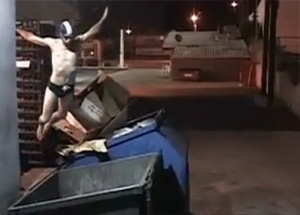 A confession: When I first saw publicity for Dive! I forwarded it to my main dumpster diving partner with the subject line: "great." As in, "great, now dumpster diving will become more popular and we'll have more competition."
A confession: When I first saw publicity for Dive! I forwarded it to my main dumpster diving partner with the subject line: "great." As in, "great, now dumpster diving will become more popular and we'll have more competition."
Since writing a feature article for Sojourners a few years back, and then being quoted in The Washington Post and filmed by the CBC, I've received a steady trickle of media requests, which, after the first flattering few, I began to decline on the basis of not wanting to bring unwanted publicity to what had become my primary (and free) food source. I'll admit that part of my media embargo was out of a selfish desire to keep all the dumpster treats to myself. I still did plenty of personal evangelism about dumpstering, but I had at least one slightly more legitimate rationalization for avoiding televangelism about it: The store where the CBC segment was filmed had started consistently chasing us away after an altercation between their employees and a dumpster diver who "got physical" with them. I didn't want a rash of media coverage to yield a crop of unseasoned divers with potentially bad attitudes ruining things for everyone else -- especially for folks who might need to dumpster dive much more than I do.
But this little 45-minute film inspired me to break my silence. Maybe it was watching it a week after Thanksgiving and Buy Nothing Day -- both of which remind me that I am blessed with abundance well beyond my need, and that buying less allows me to share more. And partly because this film reminded me of the many reasons that I started diving in the first place: Rescuing food from the landfill is both a delight and a duty. The amount of food that's routinely discarded is overwhelming in both quantity and quality -- almost magically so. And with the waste from the business of food production and distribution feeding our landfills better than many of our citizens, dumpster diving is one act of nonviolent civil resistance against the excesses of our corporate food chain.
I also hoped that this documentary, filmed on a $200 budget by L.A. resident Jeremy Seifert and friends, would answer some of the questions I've always had for store managers and corporate honchos but been afraid to ask -- mostly because my policy has been to ask for forgiveness rather than permission when approaching the alleys behind my favorite grocery stores. Seifert's persistent attempts -- by letter, phone, and in person -- were generally met with "no comment," other than the claim that they all donate food that is "safe" on a daily basis. Seifert reasserts what is obvious to any dumpster diver: There is still a lot of perfectly edible food that goes to waste. A lot.
Through some fun and creative sequences of stop-action animated dumpster food, Seifert illustrates some staggering stats about just how much food is wasted in the U.S -- that I won't reproduce here, other than to say the amount of food we throw away could feed a lot of people. I was inspired to see him and his friends getting creative about redistributing some of it on their own, and getting connected to the food bank pros that "fresh rescue" pre-discarded food from grocery stores on a daily basis. It was encouraging to learn that there are some innovators, both on the store side and the community side, but much more could be done.
There's also some discussion of the legality of dumpster diving, which has always been a murky topic, subject to the vagaries of regional jurisdictions. Some claim that dumpster diving is trespassing. But as the film illustrates, a gentle answer will generally turn away wrath when approached by police (which I've experienced multiple times myself). Truth be told, I've actually gone dumpster diving with a D.C. cop that goes to my church -- he's pretty sure it's legal. They generally just want you to explain and then cease your suspicious activity. As long as you don't give them any trouble, you can always come back another time. This generally works with surly store employees as well.
Dive! also covers a lot of familiar ground that comes up in any discussion of dumpster diving with the uninitiated: How many items (such as a carton of eggs or pack of tomatoes) are discarded because only one has been smushed, but the rest are perfectly fine; how to evaluate dumpster meat by temperature and color; how (or if) to inform your dinner guests as to how their food was obtained; the value of a chest freezer; and the considerable work it takes to sort and clean a fridge-full of dumpster food.
So if anyone takes inspiration from this article to try their hand at dumpster diving, so be it. Even if that means sharing the stash at some of my favorite D.C. area locations (though I won't list them here). But if you do go, know the three rules of dumpstering that Dive! presents from the start:
1. Never take more than you need (or can share with others)
2. First ones to the dumpster get first dibs -- but always share
3. Leave it cleaner than you found it
To which I would add: Be nice to employees and cops.
Ryan Rodrick Beiler is the Web Editor for Sojourners and a photographer whose work can be seen at www.ryanrodrickbeiler.com.
Got something to say about what you're reading? We value your feedback!